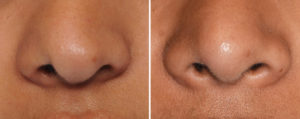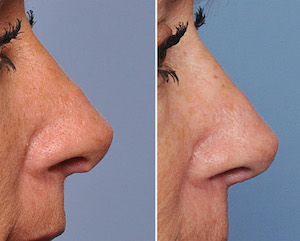The shape of the lower third of the nose is impacted by the shape of the nostrils and the central columella that runs between them. In both front and side views the cephalocaudal relationship between the alar rim and columella has a known set of values which is determined by a horizontal line drawn halfway between the columellar-lobular angle and the tip defining points. The highest point of the alar rim should fall close to his line. Whether by natural development, prior rhinoplasty surgery or trauma, the alar-columellar relationship can be adversely affected.
In the August 2019 issue of the journal Plastic and Reconstructive Surgery an article was published entitled ‘Revisiting the Alar-Columellar Relationship: Classification and Correction’. In this paper the authors discuss the alar-columellar relationship and its impact on the aesthetics of the lower third of the nose. They specifically detail the six abnormalities of this relationship including the hanging columella (Type 1), the retracted ala (Type 2), combined type I and 2 (Type 3), the hanging ala (Type 4), the retracted columella (Type 5) and combined type 4 and 5. (Type 6)
The main benefit of a classificaion system is to make the proper diagnosis and apply the correct treatment. This can consist of various maneuvers including alar rim lowering/raising, columellar lowering/raising or some combination of both.


TYPE 4. The hanging ala is treated by excision of vestibular lining or , in more severe cases, may require trimming of the caudal edge of the lower alar cartilage.
TYPE 5. The retracted columella can be treated by a columellar onlay graft, a columellar strut cartilage graft that pushes off of the caudal septum or a septal extension cartilage graft.
Many alar-columellar relationship deformities are seen after prior rhinoplasties or trauma in my experience. Making their diagnosis sometimes is easy but other times is more challenging when they are mixed Types 3 and 6. In most cases cartilage grafting or excision are the primary reconstructive techniques.
Dr. Barry Eppley
Indianapolis, Indiana



